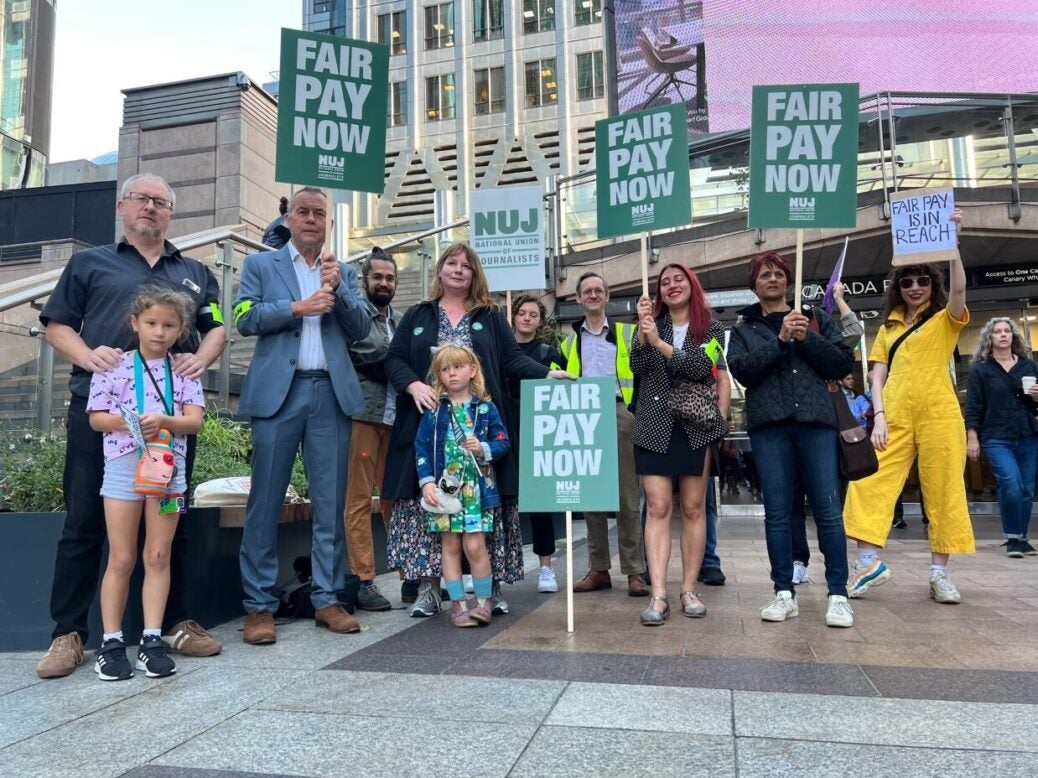
The median media industry salary reported by respondents to Press Gazette’s pay salary survey for 2022 was £41,700.
Some 242 people shared their salary information with us and the majority of respondents (209) were from the UK.
The issues of low pay and insecure conditions have galvanised those working in the industry to voice their discontent over several months of strikes and threats of industrial action at publishers including Reach and National World.
But the median pay reported by respondents to our survey was higher than the average UK salary, which according to the government’s Office of National Statistics was £31,285 in 2021.
However, a significant minority (16%) of UK, US and European respondents reported salaries of less than £25,000.
Last week we also revealed that most of Press Gazette’s readers got a pay rise this year.
More than 260 respondents filled in our salary survey, which was carried out in October and November and was sent only to newsletter subscribers.
Respondents came from the news media and PR industries in the UK and abroad, and included freelances, people working for small news outlets as well as senior executives working for some of the biggest names in news. While survey respondents were self-selecting meaning that we have to be careful about the conclusions drawn, the responses shared can give some insights into the state of media pay in 2021 and 2022. Where respondents reported salary data in different currencies, we converted this into pounds at the current rate.
UK news industry pay rises: Survey analysis of pay
Overall, we found that 48% of respondents who shared their salary information with us reported that they made between £25,000 and £49,000 in 2021 with a further 25% reporting a salary between £50,000 and £75,000. We excluded the ten respondents from outside the UK, US and EU from this as salaries in some other countries will be lower to reflect the cost of living in those countries.
While the median salary in the UK was £41,700, this was £43,500 in the EU but £20,700 in other countries. The median for the US was £99,960 – but this reflects that fact that there were just 12 respondents from the US, of which seven were at CEO, MD, or other C or director level.
Even within just the UK however, people with similar years of media experience reported large variations in salaries.
Among full-time workers who said they had worked less than five years, salaries ranged from £20,000 to £72,000 with some of the higher salaries found among those for example working at national publishers and media organisations in marketing/ commercial functions.
Salaries varied from £19,000 to £90,000 for those with up to ten years experience. At the most experienced end, among those with over 20 years behind them in the industry, salaries ranged from £23,200 to £210,000 with the higher salaries again seen at national brands.
We also found a lot of variation when we analysed salaries by job role. The average CEO, managing director, or other C or director-level salary was £83,900. Even discounting respondents from outside the US and UK, the median was £90,000. Although respondents were not required to state the company they work for, the data available suggests this is likely due to the fact that some respondents held senior level roles in smaller companies or local news outlets where pay tends to be lower.
One director/c-level respondent working in local media in the UK meanwhile reported a pay cheque of less than £50,000. Another working for a small public sector media organisation reported a salary of slightly over £50,000. Respondents from large-name media organisations with CEO or other C-level roles tended in contrast to report salaries in the six-figures.
Overall, we found that the average salary reported by those working for national newspapers and websites (irrespective of location) was £46,000 compared to £32,700 for those at regional or local brands.
Looking at gender, the data reveals that in most parts of the world men reported higher salaries than women. The exception was the US. The US sample was however very small and eight of the 12 US respondents were female, with four of these in senior positions, making conclusions hard to draw.
In the UK, where the larger sample of 209 was more gender diverse and included respondents in a variety of seniorities and different positions, we found that the median male salary was 8% higher than that of females.
Echoing our findings last week when we revealed that those working full-time in the office had received the largest pay rises, we also found that median salaries were higher for those working full-time from the office (£55,000) compared to £39,600 for those working fully remotely. This possibly reflects the fact that senior roles are more likely to work from the office.
Who filled out the survey?
While the poll sample was self-selecting, with readers choosing whether to take part, it still contained a large cross-section of responses from across the industry and beyond.
Respondents were anonymous but confined to verified Press Gazette email subscribers – with each subscriber only allowed to fill out the survey once.
Email pged@pressgazette.co.uk to point out mistakes, provide story tips or send in a letter for publication on our "Letters Page" blog
